South Yorkshire
Explore hidden histories, historic photos, and things you never knew about South Yorkshire from the collections and archives of Historic England.
Discover your local listed buildings and places
Introducing some of South Yorkshire's most historic sites, included in the National Heritage List for England. Some of these captions have been summarised by AI. Click through for the official List entry. Skip this section and go to place by numbers
The Dome
Doncaster
Leisure centre. Designed in 1986 to 1989 by Faulkner-Brown Hendy Watkinson Stonor for Doncaster Metropolitan Borough Council.
Sheffield Station and attached Bridges and Platform Bridges
Sheffield
A major early C20 railway station, incorporating sections of the earlier late-C19 station which had marked the completion of a new direct line from Sheffield to London via Chesterfield in...
Redmires First World War Training Area
Sheffield
First World War Training Area provided for the use of the Sheffield City Battalion, comprising numerous in-filled trench complexes and fieldworks dug late- 1914–16.
City Road Cemetery, Sheffield
Sheffield
A public cemetery opened in 1881 by the Sheffield Township Burial Board, designed by the Sheffield architectural practice of Messrs M E Hadfield and Son.
Norfolk Heritage Park
Sheffield
A public park in the centre of Sheffield, laid out as such by the Dukes of Norfolk in the early 1840s. Read the official list entry to find out more.
9, 11, Ellers Lane
Auckley
Pair of semi-detached houses. Prefabricated in Sweden and shipped to England for erection in 1948. Erected on pre-prepared bases with services provided.
Clifton Park, Rotherham
Rotherham
Clifton Park, Rotherham, established in 1891 by Joshua Walker, features mature tree avenues and landmarks like Clifton House and memorial gardens. It offers scenic views across Rotherham.
Castle House (Co-op Store)
Sheffield
Co-operative department store. 1964 by George S Hay, Chief Architect for CWS, with interior design by Stanley Layland, interior designer for CWS.
Former Cole Brothers' Department Store
Sheffield
Department store, 1963 to 1964 to designs of 1961 by Yorke, Rosenberg and Mardall (YRM). Read the official list entry to find out more.
Queen Anne's Obelisk, Off Rockley Lane, Wentworth Castle,…
Barnsley
Obelisk, dated 1734. Likely to be executed from a design by James Gibbs, constructed by the Bower family (Joseph Bower), estate masons for Thomas Wentworth, 1st Earl of Strafford.
Beauchief Hall
Sheffield
Beauchief Hall, built by Edward Pegge in 1661, showcases elaborate formal gardens and historic architecture.
Numbers 1 and 2 headstocks at the former Hatfield Main Co…
Stainforth
Two sets of colliery headstocks of contrasting designs, built as a pair in 1922. Read the official list entry to find out more.
Hickleton Hall
Barnburgh
Hickleton Hall, an 18th-century country house near Doncaster, features early 20th-century gardens and parkland developed by Lord Halifax, now serving as a Sue Ryder home.
Cannon Hall
Cawthorne
Cannon Hall is a historic estate with 1760s gardens designed by Richard Woods. Originally owned by the Canum family, it became a museum in 1951.
Police Box adjacent to Town Hall, Surrey Street, Sheffield
Sheffield
Police Box. 1928. One of a system of 120 police boxes in Sheffield instigated by Chief Constable Percy J Sillitoe. Timber. Square in plan. Read the official list entry to find out more.
Wentworth Castle Gardens
Stainborough
Formal gardens which were laid out in the period around 1713-30 with mid C18 additions surrounded by parkland of early and mid C18 date. Read the official list entry to find out more.
Lindholme Neolithic timber trackway and platform
Hatfield
Late Neolithic timber trackway and platform surviving as buried, waterlogged remains.
Monument Grounds, Sheffield
Sheffield
Monument Grounds in Sheffield features the 1832 cholera burial site, the 1834-5 Cholera Monument by M E Hadfield, and 19th-century pleasure grounds donated to the city in 1930.
Cholera Monument
Sheffield
Monument, 1835 by Matthew Ellison Hadfield to commemorate those who died in Sheffield in the Asiatic cholera epidemic of 1832.
Memorial to Huskar Pit Disaster
Silkstone
Memorial, erected in 1841. Read the official list entry to find out more.
Unsliven Bridge, Stocksbridge
Stocksbridge
Single-span road-bridge, built about 1730 and widened twice, the last occasion in 1796. Read the official list entry to find out more.
Sandbeck Park and Roche Abbey
Laughton-en-le-Morthen
Sandbeck Park, designed by Lancelot Brown for the fourth Earl of Scarbrough, incorporates elements from a 17th-century park and features Roche Abbey, which dates back to 1147.
Sheffield General Cemetery
Sheffield
Cemetery of 1836 designed by Sheffield architect Samuel Worth (fl.1830) with a chapel, catacombs and a cemetery office, and a layout which makes dramatic use of a quarried hillside site.
Oughtibridge Hall and Outbuilding
Bradfield
Farmhouse and outbuilding. An open hall and east cross wing of probable medieval origins (C15), a late C16 west cross wing (around 1581).
Weston Park
Sheffield
Weston Park, opened in 1875, originated from Weston Hall grounds, redesigned by Robert Marnock. It features a museum, art gallery, and various historical monuments.
Sheffield Botanical Gardens
Sheffield
The Sheffield Botanical Gardens, established in 1834 by Robert Marnock, feature Victorian conservatories and diverse plant collections managed by Sheffield City Council since 1957.
Obelisk to Lady Mary Wortley Montagu (Sun Monument)
Stainborough
Obelisk dedicated to Lady Mary Wortley Montagu. 1730s to 1740s, probably erected by William Wentworth, Second Earl of Strafford. Restored in 2008. Sandstone ashlar.
Barnsley Main Colliery engine house and pithead structures
Barnsley
Disused colliery winding engine house and pit head structures of circa 1900 origin, but modernised 1956.
St James' Pool and Health Club
Doncaster
Public Baths, Turkish and Russian baths suite, and winter concert hall, 1932. Built to designs by the Borough Estates Surveyor, Mr R E Ford.
Porter Valley Parks
Sheffield
Porter Valley Parks is a series of parks and green spaces in Sheffield, created between 1885 and 1938 along the Porter Brook, incorporating Endcliffe Wood and Forge Dam.
Thorne Hall, Ellison Street, Thorne
Thorne
Large house, most recently local authority offices. Mid-late C18 with early-C19 alterations, and later extensions. Roughcast rendered brick, Welsh slate roofs.
Penistone War Memorial
Penistone
First World War Memorial, about 1924, designed by John Alfred Gotch of Kettering. Read the official list entry to find out more.
The Dell, Doncaster
Doncaster
The Dell was designed by R.E. Forth in 1929 as a quarry garden in Hexthorpe Flatts, featuring specimen trees, rock gardens, a bandstand, and historical illuminations.
41-43 Church Street, Barnsley, South Yorkshire
Barnsley
Hall and cross wing house. Later C15, with hall timbers dated by dendrochronology to between AD 1455 and AD 1479, and the cross wing built in or shortly after the winter/spring of AD 1463-4.
Abbeydale Picture House
Sheffield
Cinema, 1920 with late C20 alterations, by Dixon and Stienlet of North Shields, steel frame clad in white faience tiles to principal north-west and north-east elevations and brick to rear...
Monument to Thomas Boulsover on north side of Wire Mill Dam
Sheffield
Monument of 1929, designed by J R Wigfull for David Flather, Master Cutler 1926-1927. Classical style. Read the official list entry to find out more.
Explore more
Search for more listed placesSouth Yorkshire through time
This timeline shows the first period of use for buildings and places on the National Heritage List for England, just one of the details recorded for every list entry. Click around to see how South Yorkshire changes over time. Skip this section and go to aerial photos
Prehistoric Before AD 43
Prehistory covers a million years of human occupation before the Roman invasion and the introduction of writing. Primarily hunter-gatherers of several human species including Neanderthals, the peoples moved across Europe, hunting animals, exchanging ideas and developing complex culture and belief systems including burial rites and astronomical understanding, as at Stonehenge for example.
Roman AD 43 to AD 410
Britain was invaded by four legions of the Roman army in AD 43, who relatively rapidly conquered England from landing points in Kent. Parts of Wales and Scotland soon followed.
Roman culture brought urbanism, monumental buildings, wide-ranging religious beliefs, writing, and strong social hierarchy. The Roman administrative system was withdrawn in AD 410.
Early medieval AD 410 to AD 1066
This period, often associated in England with Anglo-Saxons and Vikings, saw a reduction in urban living from the Roman period and increased migration from northern Europe.
Traces of this period can be found in cemeteries, particularly in artefacts and in some of the very early churches, as this period also saw the growth of Christianity in Britain.
Medieval AD 1066 to AD 1540
This period, sometimes known as the Middle Ages, began with the Norman invasion in AD 1066. It saw a significant rise in military and defensive buildings such as castles and earthworks, as well as religious houses dominating a largely agricultural landscape.
The monarchy and Church dominated the period, which also saw the break with the Roman Catholic Church and the English reformation.
Post medieval AD 1540 to AD 1901
The Post-Medieval period brought seismic changes to life in England, with religious reformation leading to the democratization of worship and the destruction of hundreds of religious houses.
In parallel, there was a huge expansion of scientific study and enlightenment that permanently altered the nation's social structure and landscape. Industrialization and mass production lead to wider global trade, emigration, and immigration.
20th century AD 1901 to AD 2000
The 20th century saw an incredible expansion of England's transport networks, with suburban growth shadowing rapid infrastructural expansion. The establishment of state schools, hospitals, and modern technical colleges, with new architectural styles, radically changed the appearance of towns and cities.
Two catastrophic world wars and the 1918 pandemic also brought unprecedented change, altering England's built environment and social structures forever.
Prehistoric Before AD 43
Prehistory covers a million years of human occupation before the Roman invasion and the introduction of writing. Primarily hunter-gatherers of several human species including Neanderthals, the peoples moved across Europe, hunting animals, exchanging ideas and developing complex culture and belief systems including burial rites and astronomical understanding, as at Stonehenge for example.
Roman AD 43 to AD 410
Britain was invaded by four legions of the Roman army in AD 43, who relatively rapidly conquered England from landing points in Kent. Parts of Wales and Scotland soon followed.
Roman culture brought urbanism, monumental buildings, wide-ranging religious beliefs, writing, and strong social hierarchy. The Roman administrative system was withdrawn in AD 410.
Early medieval AD 410 to AD 1066
This period, often associated in England with Anglo-Saxons and Vikings, saw a reduction in urban living from the Roman period and increased migration from northern Europe.
Traces of this period can be found in cemeteries, particularly in artefacts and in some of the very early churches, as this period also saw the growth of Christianity in Britain.
Medieval AD 1066 to AD 1540
This period, sometimes known as the Middle Ages, began with the Norman invasion in AD 1066. It saw a significant rise in military and defensive buildings such as castles and earthworks, as well as religious houses dominating a largely agricultural landscape.
The monarchy and Church dominated the period, which also saw the break with the Roman Catholic Church and the English reformation.
Post medieval AD 1540 to AD 1901
The Post-Medieval period brought seismic changes to life in England, with religious reformation leading to the democratization of worship and the destruction of hundreds of religious houses.
In parallel, there was a huge expansion of scientific study and enlightenment that permanently altered the nation's social structure and landscape. Industrialization and mass production lead to wider global trade, emigration, and immigration.
20th century AD 1901 to AD 2000
The 20th century saw an incredible expansion of England's transport networks, with suburban growth shadowing rapid infrastructural expansion. The establishment of state schools, hospitals, and modern technical colleges, with new architectural styles, radically changed the appearance of towns and cities.
Two catastrophic world wars and the 1918 pandemic also brought unprecedented change, altering England's built environment and social structures forever.
Aerial photos of South Yorkshire
Aerial photography helps reveal secrets of England's changing landscapes that are impossible to see from the ground. Skip this section and go to archive images

Loversall
Loversall Hall and St Catherine's Church, Loversall, 1950
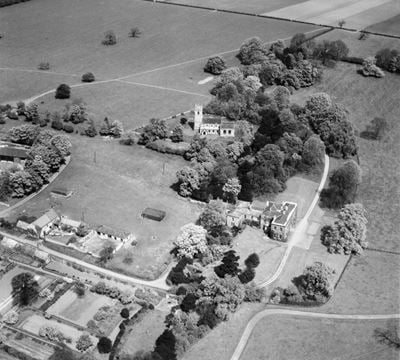
Loversall
Loversall Hall and St Catherine's Church, Loversall, 1953
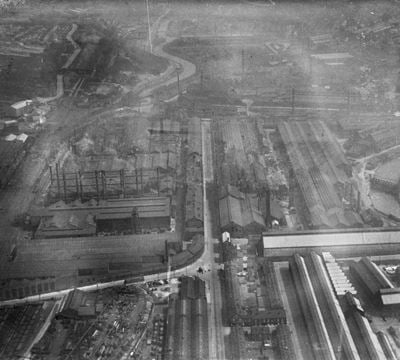
Sheffield
The Vickers Works and environs, Sheffield, 1922
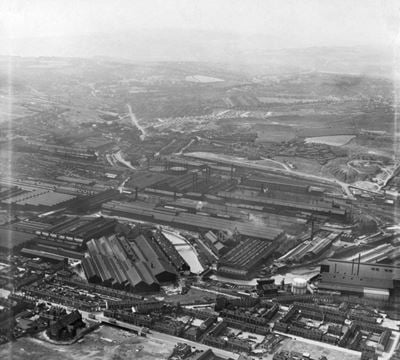
Brightside
The English Steel Corporation Ltd River Don Works and environs, Brightside, 1949
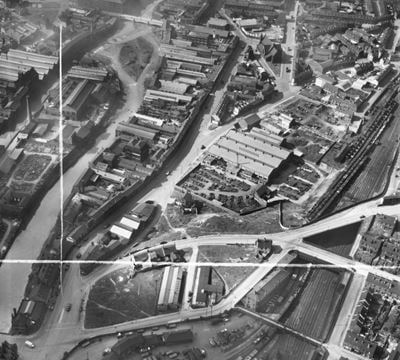
Sheffield
The Neepsend Steel and Tool Corporation Works off Mowbray Street and environs, Sheffield, 1951

Sheffield
East Range Cornish Plate Works, Cornish Street and the surrounding area, Sheffield, 1961

Whirlow
Whirlow Court and garden, Whirlow, 1952
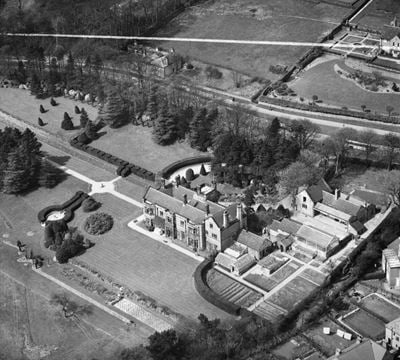
Whirlow
Whirlow Court, Whirlow, 1952
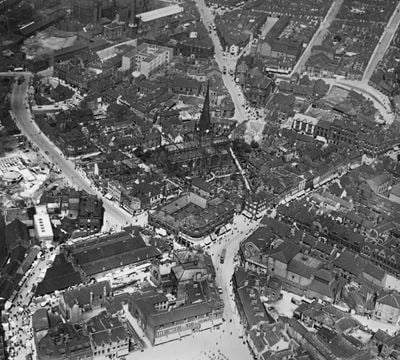
Rotherham
The town centre, Rotherham, 1926

Rotherham
The Rotherham Forge & Rolling Mills Co Ltd Works on Forge Lane and environs, Rotherham, 1953
South Yorkshire in the Historic England Archive
The Historic England Archive cares for over 15 million images, dating from the 1850s to the present day. Discover stunning images of South Yorkshire's past. Skip this section and go to stories about heritage
Charles George Harper Collection
Wentworth Park, Rotherham
Date created: 1892 - 1933
A view from the east of Wentworth Woodhouse
Eileen ‘Dusty’ Deste Collection
Rotherham
Date created: 1966 - 1974
The Orgreave Coking Plant viewed from High Field Lane looking north east towards Catcliffe
Eric de Mare
Rotherham
Date created: 1945 - 1980
General view of the Chantry Chapel from the Chantry Bridge in Rotherham.
John Gay Collection: Counties
Barnsley
Date created: 1962 - 1966
A cast iron gas lamp standard in the graveyard of St John's Church, Penistone
John Laing Collection
Sheffield
Date created: 16 Jul 1984
A view of the checkouts at the Sainsbury's supermarket in Sheffield
London, Midland and Scottish Railway Company
Sheffield
Date created: 10 Nov 1927
Men stacking boxes of biscuits in the depot of the Associated Biscuit Manufacturers Ltd, at Sheffield City Goods Station
Alfred Newton and Sons
Doncaster
Date created: 1896 - 1920
GENERAL VIEW FROM THE SOUTH LOOKING ACROSS THE RIVER
Nigel Temple Collection of Postcards of Parks and Gardens
Endcliffe, Sheffield, Sheffield
Date created: 1901 - 1906
GENERAL VIEW
Eileen ‘Dusty’ Deste Collection
Rotherham
Date created: 1966 - 1974
The Orgreave Coking Plant viewed from High Field Lane looking north east towards Catcliffe
John Laing Collection
Sheffield
Date created: 16 Jul 1984
The Sainsbury's supermarket in Sheffield, showing the carpark entrance
London, Midland and Scottish Railway Company
Sheffield
Date created: 10 Nov 1927
Bags and boxes of merchandise stored in George Bassett and Company's first floor depot at Sheffield City Goods Station
Nigel Temple Collection of Postcards of Parks and Gardens
Endcliffe, Sheffield, Sheffield
Date created: 1900 - 1905
GENERAL VIEW SHOWING THE STEPPING STONES
Stories about heritage in your local area
Historic England publishes news, blogs, research, videos, and podcasts celebrating England's rich heritage. Discover the stories we have about South Yorkshire. Skip this section and go to education
The Story of Maurice Dobson: The Tough-As-Nails, Openly Gay Ex-Miner
Mentions 2, Vicar Road
Discover the life of Maurice Dobson, who lived in Darfield, near Barnsley, whose home is now the Maurice Dobson Museum and Heritage Centre.
10 Places with Coal Mining History
Mentions The former Elsecar New Colliery,, Reform Row
Evidence of England’s coal mining heritage can still be found nationwide.
8 Sites of Scientific Discovery and Innovation
Mentions Brown-firth Laboratories, Now English Pewter Company
From Charles Darwin to Alan Turing, discover incredible places in England connected to scientific achievement.
A Brief History of Reinforced Concrete Buildings
Mentions Park Hill
Reinforcing concrete made highly complex large-scale structures possible.
A Spotter’s Guide to Victorian Architecture
Mentions Brodsworth Hall
Named after the 63 year reign of Queen Victoria, the era of 1837 to 1901 inspired unprecedented social, intellectual and technological change.
The Beautiful North
Mentions The Crucible Theatre
In April 2016, towns and cities across the North East, North West and Yorkshire were invited to bid to put on a ‘Great Exhibition of the North’, which...
9 Reasons to Look Up in Yorkshire
Mentions Town Hall
You may think you know a place well, but if you take the opportunity to look up, you may be surprised at what you discover.
Mentions South Yorkshire
Gwenda’s Garage was founded in 1985 in Sheffield, South Yorkshire, by three women mechanics: Ros Wollen (aka Roz), Annette Williams, and Ros Wall.
Sheffield’s Trailblazing Women Mechanics: The Legacy of Gwenda’s Garage
Gwenda’s Garage was founded in 1985 in Sheffield, South Yorkshire, by three women mechanics: Ros Wollen (aka Roz), Annette Williams, and Ros Wall.
Research Reports Roundup February 2025
Mentions South Yorkshire
A roundup of the latest additions to our research reports database from October 2024 to February 2025, arranged by theme.
50 Years of Flying for Heritage
Mentions Heavy Anti-aircraft gunsite 330m south east of Lowfield Farm
Learn about discoveries made in over 50 years of flying by Historic England aerial photographers and their predecessors.
New Funding to Celebrate Rural and Coastal Working-Class Heritage
Mentions South Yorkshire
Historic England is funding new projects to explore untold stories and celebrate the people and places at the heart of our history.
Repair Grant for Historic Kiln in Rotherham
Mentions South Yorkshire
Historic England have awarded Rotherham Council more than £77,000 to help save an important part of South Yorkshire’s industrial heritage.
Rare First World War Practice Trenches in Gosport Scheduled
Mentions Redmires First World War Training Area
The well-preserved site at Browndown, Gosport in Hampshire has been designated as a scheduled monument.
Historic Garden Wall in South Yorkshire to be Saved
Mentions South Yorkshire
A £55,000 grant from Historic England will save an 18th century garden wall at Cannon Hall in Barnsley from imminent collapse.
Wentworth Woodhouse Stable Buildings Given Funding Boost
Mentions The Mews, South Yorkshire
A group of derelict stable buildings on the Wentworth Woodhouse Estate are being restored thanks to a £528,475 grant from Historic England.
Community Engagement in the Elsecar Heritage Action Zone
Mentions South Yorkshire
Working with the community in the former South Yorkshire mining village of Elsecar to discover and celebrate their heritage.
16 Remarkable Historic Places Listed in 2023
Mentions The Dome, South Yorkshire
Take a closer look at the historic gems that were examined, protected and added to the National Heritage List for England in 2023.
Monument to Smallpox Pioneer Awarded Upgraded Listing Status
Mentions Obelisk to Lady Mary Wortley Montagu (Sun Monument), South Yorkshire
A monument in South Yorkshire celebrating medical pioneer Lady Mary Wortley Montagu has been upgraded to Grade II* by DCMS
Heritage at Risk in Yorkshire Revealed
Mentions Camellia House, Sheffield General Cemetery, Cannon Hall
13 sites have been saved and 7 sites added to the Heritage at Risk Register 2023 in the East of England.
Dame Julie Kenny Appointed as Historic England Commissioner
Mentions South Yorkshire
Dame Julie Kenny, founding Chair of Wentworth Woodhouse Preservation Trust, is appointed for a four-year term.
South Yorkshire's social history through photos
Over 10,000 images from the Historic England Archive have been specially selected and re-captioned for teachers, students, and anyone who wants to learn more about their local area. Skip this section and go to grant-aided places
Ye Old Carbrook Hotel, Attercliffe Common, Sheffield, South Yorkshire
Period: Stuart (1603 - 1713)
This building was originally constructed in 1620 and has since had alterations.
Ye Old Carbrook Hotel, Attercliffe Common, Sheffield, South Yorkshire
Worsbrough Ridge Mill, Worsbrough, South Yorkshire
Period: Stuart (1603 - 1713)
The former corn mill dates back to the early 17th century. With the additions made to the mill in 1843, when the mill became steam powered.
Worsbrough Ridge Mill, Worsbrough, South Yorkshire
Workshop Ranges, Well Meadow Street, Sheffield, South Yorkshire
Period: Victorian (1837 - 1901)
These workshops and attached houses were constructed in 1860.
Workshop Ranges, Well Meadow Street, Sheffield, South Yorkshire
Workshop Ranges and Crucible Furnace, Sheffield, South Yorkshire
Period: Victorian (1837 - 1901)
These workshops, furnace and houses were constructed in c1840.
Workshop Ranges and Crucible Furnace, Sheffield, South Yorkshire
Workers housing, Reform Row, Wath Road, Elsecar, South Yorkshire
Period: Victorian (1837 - 1901)
Employers often needed to supply their workforce with accommodation, the quality of which varied greatly.
Workers housing, Reform Row, Wath Road, Elsecar, South Yorkshire
Workers housing, Bradfield, South Yorkshire
Period: Georgian (1714 - 1836)
This terrace of houses known as Riverside Cottages, was built in the 18th century. It was altered in the mid-to-late 19th century.
Workers housing, Bradfield, South Yorkshire
Wharncliffe Lodge, Stocksbridge, Sheffield, South Yorkshire
Period: Georgian (1714 - 1836)
This lodge was largely built in the 18th century. It is built on the site of an earlier house from 1510.
Wharncliffe Lodge, Stocksbridge, Sheffield, South Yorkshire
Westbrook House, Sheffield, South Yorkshire
Period: Georgian (1714 - 1836)
Westbrook House was built in 1794-5. It is now used by the Sheffield Area Health Authority as offices.
Westbrook House, Sheffield, South Yorkshire
Visit grant-aided places near you
These places and buildings have been helped by Historic England's financial grants. Find historic places in your neighbourhood that you never knew existed! Please note that opening times may vary. Skip this section and go to related locations
Elsecar Colliery Newcomen Engine, Barnsley
Built in 1795, this facility extracted water from Elsecar New Colliery, enabling the exploration of deeper coal seams.
Green Lane Works Archway, Green Lane
Constructed in 1860, this works entrance once provided access to the site and its industrial activities.
Wentworth Woodhouse, Wentworth
Wentworth Woodhouse, a Grade I Listed country house in South Yorkshire, formerly housed a Prime Minister and is now managed by the Wentworth Woodhouse...
Park Hill Flats, Talbot Street
Concrete frame and new concrete balustrades to the streets in the sky.
Keppel's Column, Admiral's Crest
A grade II* listed 115ft folly with a spiral internal staircase and viewing platform at the top.


